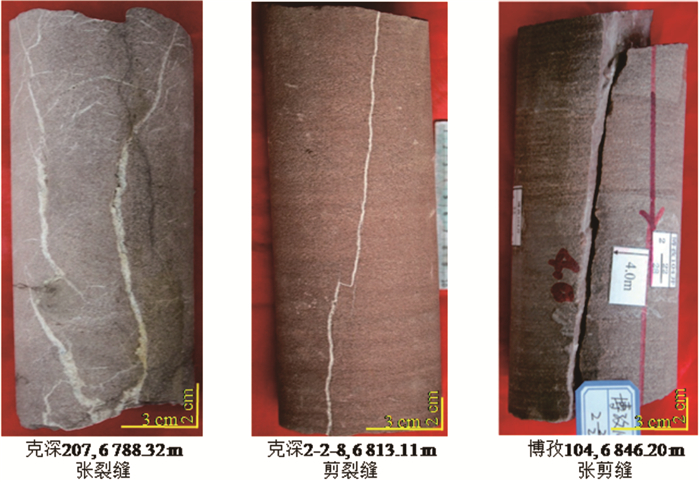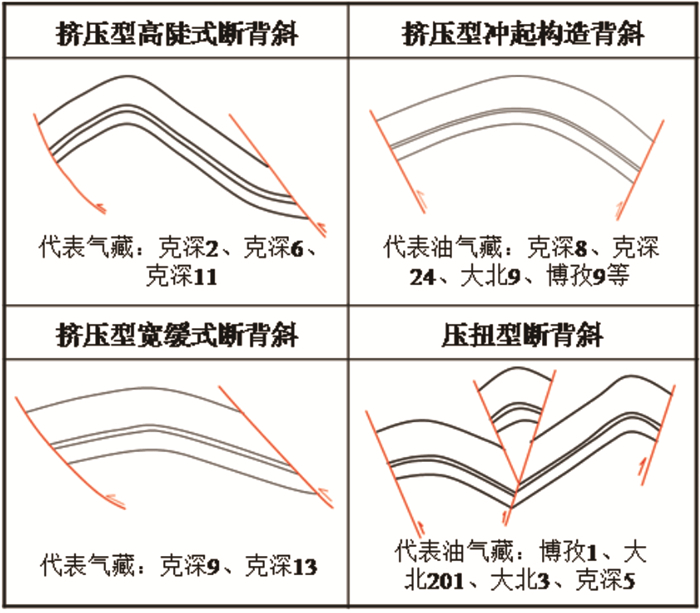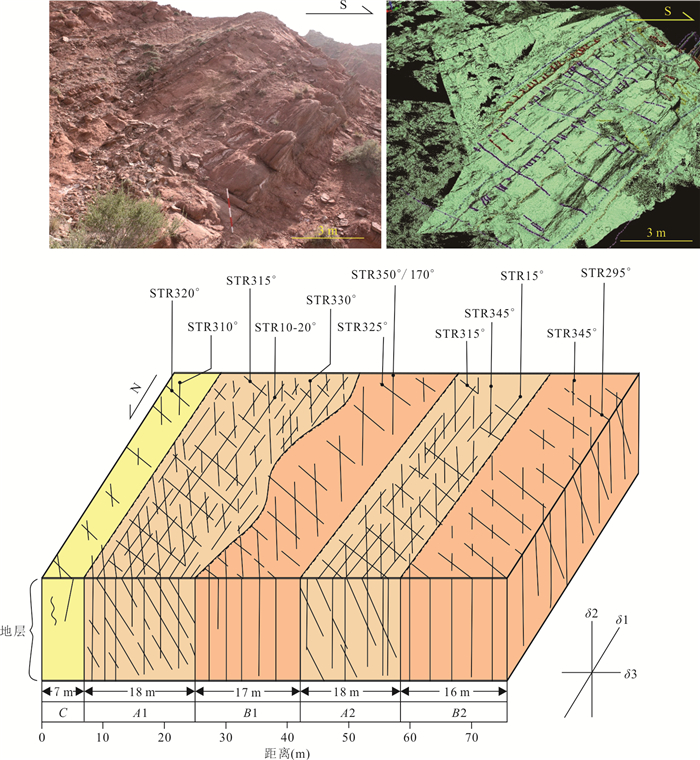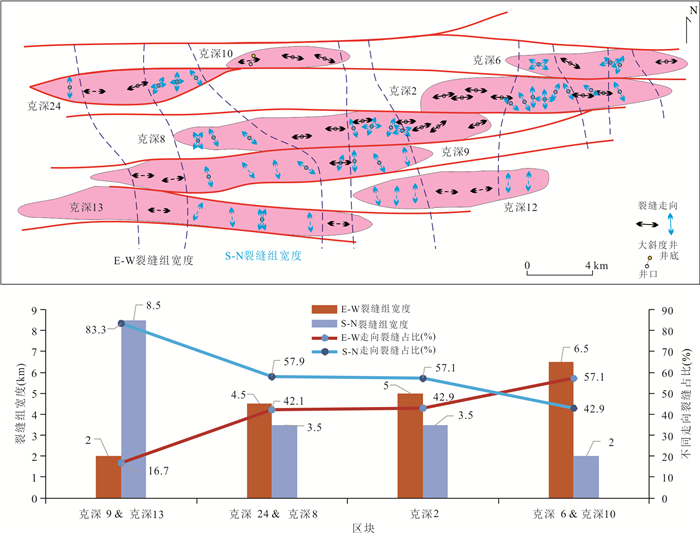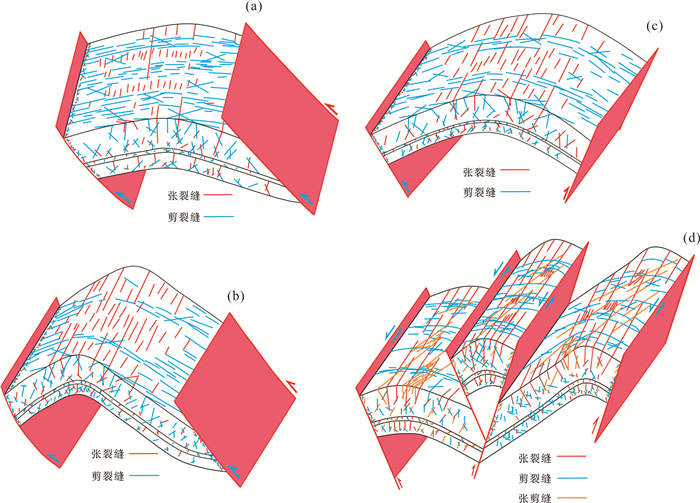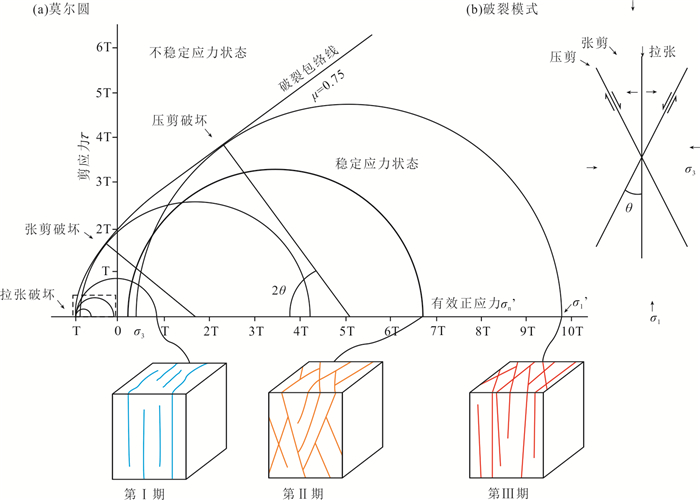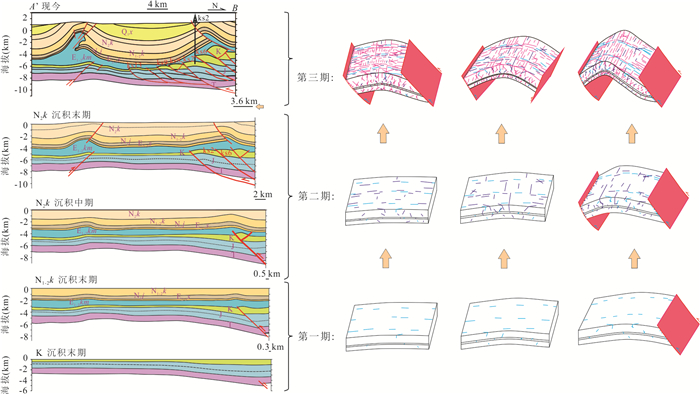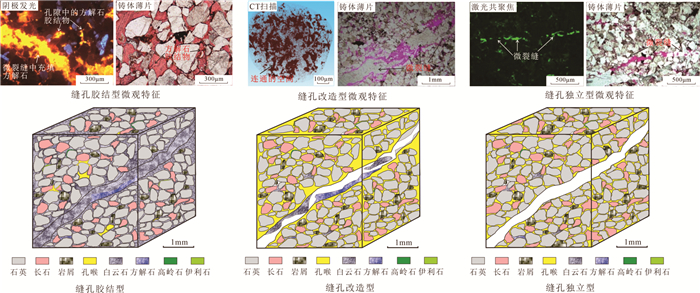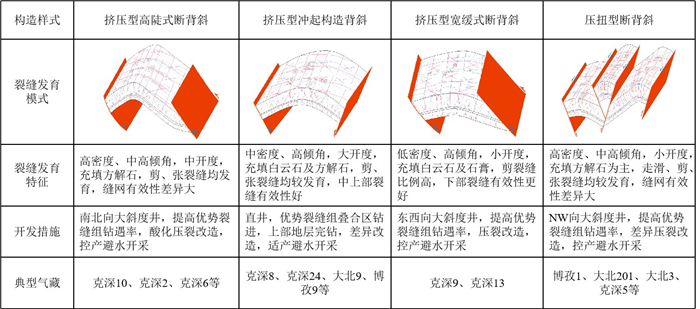Development Model of Natural Fractures in Ultra-Deep Sandstone Reservoirs with Low Porosity in Kelasu Tectonic Belt, Tarim Basin
-
摘要: 塔里木盆地克拉苏大气区是我国“西气东输”的重要战略气源地,构造裂缝对油气井高产稳产具有控制作用,但分布规律认识仍不明确.通过露头区激光雷达扫描、岩心及井下电成像,结合铸体薄片、激光共聚焦、CT扫描、碳氧同位素分析、阴极发光等实验方法,开展了裂缝成因机制分析及开发策略总结.认识到克拉苏大气区整体发育4类典型构造变形样式、3种构造裂缝类型、3类微裂缝与基质孔喉配置关系.该区构造裂缝具有“疏密相间、成簇分布”的特征,裂缝带宽度为2~6.5 km;自北向南,采取垂直裂缝优势走向钻进大斜度井并采取差异化改造措施,可提高有效缝网的钻遇率及规避底水上侵.Abstract: Kelasu gas field of Kuqa foreland thrust belt in Tarim Basin is an important strategic gas-producing area for China's "West to East Gas Transmission" project. Structural fractures are widely developed, and it plays an obvious role in controlling the high and stable production of oil and gas wells. However, the distribution of fractures is still unclear. In this paper, the genetic mechanism of fractures, as well as the reservoir development tactics were summarized and analyzed through core fracture measurement, outcrop fracture Ridar scanning, FMI data, analyzing grouting thin section, laser confocal, CT scanning, and cathodoluminescence (CL) results. There are four types of structural deformation styles, three types of structural fractures, as well as three types of relationships between pores, throats and micro-fractures in Kelasu gas field. The structural fracture in this region is characterize by alternating density and clustered distribution, with a width of 2-6 km. To promote the fracture penetration rate effectively, and to avoid the invasion of bottom water at the same time, it is suggested to, drill highly deviated wells vertical to structural fractures, from north to south, in combination with differentiated reservoir reconstruction.
-
Key words:
- ultra⁃deep /
- tight sandstone /
- fracture model /
- reservoir /
- Tarim Basin /
- petroleum geology
-
图 4 克拉苏气田典型构造变形样式(据魏国齐等,2020修改)
Fig. 4. The typical tectonic deformation styles in Kelasu Gas Field (modified from Wei et al., 2020)
图 5 克拉苏气田露头区卡普沙良河剖面巴什基奇克组裂缝与地层关系、主节理系统(裂缝)模式
A为两期节理系发育带:A1为走向315°主节理系为主;A2为走向15°主节理系为主.B为单期节理系发育带:B1为走向350°主节理系为主,B2为走向295°主节理系为主.C为节理系不发育带
Fig. 5. The relationship between fractures and stratum of Bashijiqike Formation in Kapushaliang river section in Kelasu Gas Field, major joints (fractures) systematic pattern
图 8 克拉苏气田不同构造样式下裂缝排列方式及破裂机制(据Cosgrove and Ameen, 1999修改)
Fig. 8. The arrangement mode and rupture mechanism of fractures under different tectonic styles in Kelasu Gas Field (modified from Cosgrove and Ameen, 1999)
-
Aguilera, R., 1995. Naturally Fractured Reservoirs (2nd Edition). Penn Well Publishing Company, Tulsa, Oklahoma, 211-268. Ajdukiewicz, J. M., Nicholson, P. H., Esch, W. L., 2010. Prediction of Deep Reservoir Quality Using Early Diagenetic Process Models in the Jurassic Norphlet Formation, Gulf of Mexico. AAPG Bulletin, 94(8): 1189-1227. https://doi.org/10.1306/04211009152 Cao, B. F., Bai, G. P., Wang, Y. F., 2013. More Attention Recommended for Global Deep Reservoirs. Oil & Gas Journal, 111(9): 78-85. doi: 10.3969/j.issn.1006-6896.2013.9.045 Chen, B., Tian, C. L., 1998. Oil Field Development Abstract Numerical Simulation Technique for Structural Fractures in a Reservoir: Case Studies. Acta Petrolei Sinica, 19(4): 50-54 (in Chinese with English abstract). Cosgrove, J. W., Ameen, M. S., 1999. A Comparison of the Geometry, Spatial Organization and Fracture Patterns Associated with Forced Folds and Buckle Folds. Geological Society, London, Special Publications, 169(1): 7-21. https://doi.org/10.1144/gsl.sp.2000.169.01.02 Deng, H. C., Zhou, W., Zhou, Q. M., et al., 2013. Quantification Characterization of the Valid Natural Fractures in the 2nd Xu Member, Xinchang Gas Field. Acta Petrologica Sinica, 29(3): 1087-1097 (in Chinese with English abstract). Feng, J. W., Dai, J. S., Ma, Z. R., et al., 2011. The Theoretical Model between Fracture Parameters and Stress Field of Low-Permeability Sandstones. Acta Petrolei Sinica, 32(4): 664-671 (in Chinese with English abstract). Feng, Y. W., Chen, Y., Zhao, Z. Y., et al., 2021. Migration of Natural Gas Controlled by Faults of Majiagou Formation in Central Ordos Basin: Evidence from Fluid Inclusions. Earth Science, 46(10): 3601-3614 (in Chinese with English abstract). doi: 10.1007/s12182-020-00522-1?utm_source=TrendMD He, D. F., Jia, C. Z., Li, D. S., et al., 2005. Formation and Evolution of Polycyclic Superimposed Tarim Basin. Oil & Gas Geology, (1): 64-77 (in Chinese with English abstract). Hou, G. T., Pan, W. Q., 2013. Geological modeling and mechanical mechanism of fractures. Science Press, Beijing (in Chinese). Jia, C. Z., Pang, X. Q., 2015. Research Processes and Main Development Directions of Deep Hydrocarbon Geological Theories. Acta Petrolei Sinica, 36(12): 1457-1469 (in Chinese with English abstract). Jia, C. Z., Zou, C. N., Li, J. Z., et al., 2012. Assessment Criteria, Main Types, Basic Features and Resource Prospects of the Tight Oil in China. Acta Petrolei Sinica, 33(3): 343-350 (in Chinese with English abstract). Lander, R. H., Laubach, S. E., 2015. Insights into Rates of Fracture Growth and Sealing from a Model for Quartz Cementation in Fractured Sandstones. Geological Society of America Bulletin, 127(3-4): 516-538. https://doi.org/10.1130/b31092.1 Laubach, S. E., Olson, J. E., Gross, M. R., 2009. Mechanical and Fracture Stratigraphy. AAPG Bulletin, 93(11): 1413-1426. https://doi.org/10.1306/07270909094 Liu, C., Zhang, R. H., Zhang, H. L., et al., 2017a. Genesis and Reservoir Significance of Multi-Scale Natural Fractures in Kuqa Foreland Thrust Belt, Tarim Basin, NW China. Petroleum Exploration and Development, 44(3): 463-472 (in Chinese with English abstract). Liu, C., Zhang, R. H., Zhang, H. L., et al., 2017b. Fracture Development of Different Structural Styles in Kuqa Foreland Thrust Belt: From Outcrop Observation of Structural Fracture. Natural Gas Geoscience, 28(1): 52-61 (in Chinese with English abstract). Liu, G. P., Zeng, L. B., Zhu, R. K., et al., 2021. Effective Fractures and Their Contribution to the Reservoirs in Deep Tight Sandstones in the Kuqa Depression, Tarim Basin, China. Marine and Petroleum Geology, 124: 104824. https://doi.org/10.1016/j.marpetgeo.2020.104824 Lorenz, J. C., Teufel, L. W., Warpinski, N. R., 1991. Regional Fractures Ⅰ: A Mechanism for the Formation of Regional Fractures at Depth in Flat-Lying Reservoirs. AAPG Bulletin, 75 (11): 1714-1737. https://doi.org/10.1306/0C9B29E3-1710-11D7-8645000102C1865D Narr, W., Suppe, J., 1991. Joint Spacing in Sedimentary Rocks. Journal of Structural Geology, 13(9): 1037-1048. https://doi.org/10.1016/0191-8141(91)90055-n Nelson, R. A., 1985. Geologic Analysis of Naturally Reservoirs. Gulf Publishing Company, Houston. Olson, J. E., Laubach, S. E., Lander, R. H., 2009. Natural Fracture Characterization in Tight Gas Sandstones: Integrating Mechanics and Diagenesis. AAPG Bulletin, 93(11): 1535-1549. https://doi.org/10.1306/08110909100 Shang, L., Dai, J. S., Jia, K. F., et al., 2013. Numerical Simulation for the Distribution of Different Levels of Tectonic Fractures in Carbonate Buried Hills: Taking Futai Oilfield in Bohai Bay Basin as an Example. Natural Gas Geoscience, 24(6): 1260-1267 (in Chinese with English abstract). Shi, C. Q., Wang, Z. T., Zhu, W. H., et al., 2020. Fracture Characteristic and Its Impact on Reservoir Quality of Ultra-Deep Reservoir in Dabei Region, Kelasu Tectonic Belt, Kuqa Depression, Tarim Basin. Natural Gas Geoscience, 31(12): 1687-1699 (in Chinese with English abstract). Sun, L. D., Zou, C. N., Zhu, R. K., et al., 2013. Formation, Distribution and Potential of Deep Hydrocarbon Resources in China. Petroleum Exploration and Development, 40(6): 641-649 (in Chinese with English abstract). Sun, X. W., Hou, G. T., Yu, X., et al., 2015. Model for the Fracture Development of the Sand with Low-Permeability in the Foreland Faulted Fold Belt. Geotectonica et Metallogenia, 39(5): 808-815 (in Chinese with English abstract). Wang, J. P., Zeng, L. B., Yang, X. Z., et al., 2021. Fold-Related Fracture Distribution in Neogene, Triassic, and Jurassic Sandstone Outcrops, Northern Margin of the Tarim Basin, China: Guides to Deformation in Ultradeep Tight Sandstone Reservoirs. Lithosphere, 2021: 1-17. https://doi.org/10.2113/2021/8330561 Wang, J. P., Zhang, H. L., Zhang, R. H., et al., 2018. Enhancement of Ultra-Deep Tight Sandstone Reservoir Quality by Fractures: A Case Study of Keshen Gas Field in Kuqa Depression, Tarim Basin. Oil & Gas Geology, 39(1): 77-88 (in Chinese with English abstract). Wang, J. P., Zhang, R. H., Zhao, J. L., et al., 2014. Characteristics and Evaluation of Fractures in Ultra-Deep Tight Sandstone Reservoir: Taking Keshen Gasfield in Tarim Basin, NW China as an Example. Natural Gas Geoscience, 25(11): 1735-1745 (in Chinese with English abstract). Wang, K., Yang, H. J., Li, Y., et al., 2020. Formation Sequence and Distribution of Structural Fractures in Compact Sandstone Reservoir of Keshen Gas Field in Kuqa Depression, Tarim Basin. Geotectonica et Metallogenia, 44(1): 30-46 (in Chinese with English abstract). Wang, K., Zhang, H. L., Zhang, R. H., et al., 2017. Quantitative Characterization and Distribution Prediction of Structural Fracture in Ultra-Deep Tight Sandstone Reservoir—A Case Study of Keshen5 Gas Pool in Kuqa Depression of Tarim Basin. Journal of Earch Sciences and Environment, 39(5): 652-668 (in Chinese with English abstract). doi: 10.3969/j.issn.1672-6561.2017.05.004 Wang, Z., Lü, X. X., Zhang, L. X., et al., 2023. Discovery of "Quartz Bridge" in Kuqa Foreland Thrust Belt and Its Geological Significance. Earth Science, 48(1): 342-358 (in Chinese with English abstract). Wang, Z. Y., Tao, X. Y., Fan, P., et al., 2014. Distribution Rule of Fractures and Their Effect on Deliverability in Sandstone Reservoirs, Dabei Gas Field, Kuqa Foreland Basin. Petroleum Geology and Recovery Efficiency, 21(2): 51-56, 114 (in Chinese with English abstract). doi: 10.3969/j.issn.1009-9603.2014.02.014 Wei, G. Q., Wang, J. P., Zeng, L. B., et al., 2020. Structural Reworking Effects and New Exploration Discoveries of Subsalt Ultra-Deep Reservoirs in the Kelasu Tectonic Zone. Natural Gas Industry, 40(1): 20-30 (in Chinese with English abstract). Yang, H. J., Zhang, R. H., Yang, X. Z., et al., 2018. Characteristics and Reservoir Improvement Effect of Structural Fracture in Ultra-Deep Tight Sandstone Reservoir: A Case Study of Keshen Gasfield, Kuqa Depression, Tarim Basin. Natural Gas Geoscience, 29(7): 942-950 (in Chinese with English abstract). Yang, X. W., Tian, J., Wang, Q. H., et al., 2021. Geological Understanding and Favorable Exploration Fields of Ultra-Deep Formations in Tarim Basin. China Petroleum Exploration, 26(4): 17-28 (in Chinese with English abstract). doi: 10.3969/j.issn.1672-7703.2021.04.002 Zeng, L. B., 2008. Formation and Distribution of Fractures in Low Permeability Sandstone Reservoirs. Science Press, Beijing (in Chinese). Zeng, L. B., Li, Y. G., Wang, Z. G., et al., 2007. Type and Sequence of Fractures in the Second Member of Xujiahe Formation at the South of Western Sichuan Depression. Earth Science, 32(2): 194-200 (in Chinese with English abstract). Zeng, L. B., Lyu, P., Qu, X. F., et al., 2020. Multi-Scale Fractures in Tight Sandstone Reservoirs with Low Permeability and Geological Conditions of Their Development. Oil & Gas Geology, 41(3): 449-454 (in Chinese with English abstract). Zeng, L. B., Lyu, W. Y., Zhang, Y. Z., et al., 2021. The Effect of Multi-Scale Faults and Fractures on Oil Enrichment and Production in Tight Sandstone Reservoirs: A Case Study in the Southwestern Ordos Basin, China. Frontiers in Earth Science, 9: 664629. https://doi.org/10.3389/feart.2021.664629 Zeng, L. B., Zhou, T. W., 2004. Reservoir Fracture Distribution Law of Kuche Depression in Talimu Basin. Natural Gas Industry, 24(9): 23-25 (in Chinese with English abstract). Zeng, L. B., Zhou, T. W., Lü, X. X., 2002. Influence of Himalayan Orogeny on Oil & Gas Forming in Kuqa Depression, Tarim Basin. Earth Science, 27(6): 741-744 (in Chinese with English abstract). doi: 10.3321/j.issn:1000-2383.2002.06.015 Zhang, H. L., Zhang, R. H., Yang, H. J., et al., 2014. Characterization and Evaluation of Ultra-Deep Fracture-Pore Tight Sandstone Reservoirs: a Case Study of Cretaceous Bashijiqike Formation in Kelasu Tectonic Zone in Kuqa Foreland Basin, Tarim, NW China. Petroleum Exploration and Development, 41(2): 158-167 (in Chinese with English abstract). Zhang, Z. P., Wang, Q. C., 2004. Development of Joints and Shear Fractures in the Kuqa Depression and Its Implication to Regional Stress Field Switching. Scientia Sinica Terrae, 34(S1): 63-73 (in Chinese). Zhou, L., Mo, T., Wang, Z. H., et al., 2017. Classification and Combination Characteristics of Fractures in Super-Deep Tight Sandstone Reservoir of Keshen Gasfield in Tarim Basin. Natural Gas Geoscience, 28(11): 1668-1677 (in Chinese with English abstract). Zhuo, Q. G., Li, Y., Song, Y., et al., 2013. Evolution of Paleogene Saline Deposits and Effectiveness of Traps in Kelasu Tectonic Zone, Kuqa Depression, Tarim Basin. Petroleum Geology & Experiment, 35(1): 42-47 (in Chinese with English abstract). 陈波, 田崇鲁, 1998. 储层构造裂缝数值模拟技术的应用实例. 石油学报, 19(4): 50-54. doi: 10.3321/j.issn:0253-2697.1998.04.009 邓虎成, 周文, 周秋媚, 等, 2013. 新场气田须二气藏天然裂缝有效性定量表征方法及应用. 岩石学报, 29(3): 1087-1097. https://www.cnki.com.cn/Article/CJFDTOTAL-YSXB201303029.htm 冯建伟, 戴俊生, 马占荣, 等, 2011. 低渗透砂岩裂缝参数与应力场关系理论模型. 石油学报, 32(4): 664-671. https://www.cnki.com.cn/Article/CJFDTOTAL-SYXB201104017.htm 冯艳伟, 陈勇, 赵振宇, 等, 2021. 鄂尔多斯盆地中部地区马家沟组断裂控制天然气运移方向的流体包裹体证据. 地球科学, 46(10): 3601-3614. doi: 10.3799/dqkx.2020.384 侯贵廷, 潘文庆, 2013. 裂缝地质建模及力学机制. 北京: 科学出版社. 何登发, 贾承造, 李德生, 等, 2005. 塔里木多旋回叠合盆地的形成与演化. 石油与天然气地质, (1): 64-77. https://www.cnki.com.cn/Article/CJFDTOTAL-SYYT200501009.htm 贾承造, 庞雄奇, 2015. 深层油气地质理论研究进展与主要发展方向. 石油学报, 36(12): 1457-1469. https://www.cnki.com.cn/Article/CJFDTOTAL-SYXB201512001.htm 贾承造, 邹才能, 李建忠, 等, 2012. 中国致密油评价标准、主要类型、基本特征及资源前景. 石油学报, 33(3): 343-350. https://www.cnki.com.cn/Article/CJFDTOTAL-SYXB201203000.htm 刘春, 张荣虎, 张惠良, 等, 2017a. 库车前陆冲断带多尺度裂缝成因及其储集意义. 石油勘探与开发, 44(3): 463-472. https://www.cnki.com.cn/Article/CJFDTOTAL-SKYK201703019.htm 刘春, 张荣虎, 张惠良, 等, 2017b. 塔里木盆地库车前陆冲断带不同构造样式裂缝发育规律: 证据来自野外构造裂缝露头观测. 天然气地球科学, 28(1): 52-61. https://www.cnki.com.cn/Article/CJFDTOTAL-TDKX201701006.htm 商琳, 戴俊生, 贾开富, 等, 2013. 碳酸盐岩潜山不同级别构造裂缝分布规律数值模拟——以渤海湾盆地富台油田为例. 天然气地球科学, 24(6): 1260-1267. https://www.cnki.com.cn/Article/CJFDTOTAL-TDKX201306023.htm 史超群, 王佐涛, 朱文慧, 等, 2020. 塔里木盆地库车坳陷克拉苏构造带大北地区超深储层裂缝特征及其对储层控制作用. 天然气地球科学, 31(12): 1687-1699. https://www.cnki.com.cn/Article/CJFDTOTAL-TDKX202012004.htm 孙龙德, 邹才能, 朱如凯, 等, 2013. 中国深层油气形成、分布与潜力分析. 石油勘探与开发, 40(6): 641-649. https://www.cnki.com.cn/Article/CJFDTOTAL-SKYK201306001.htm 孙雄伟, 侯贵廷, 于璇, 等, 2015. 库车前陆冲断带低渗砂岩的裂缝发育模式. 大地构造与成矿学, 39(5): 808-815. https://www.cnki.com.cn/Article/CJFDTOTAL-DGYK201505005.htm 王俊鹏, 张惠良, 张荣虎, 等, 2018. 裂缝发育对超深层致密砂岩储层的改造作用——以塔里木盆地库车坳陷克深气田为例. 石油与天然气地质, 39(1): 77-88. https://www.cnki.com.cn/Article/CJFDTOTAL-SYYT201801009.htm 王俊鹏, 张荣虎, 赵继龙, 等, 2014. 超深层致密砂岩储层裂缝定量评价及预测研究——以塔里木盆地克深气田为例. 天然气地球科学, 25(11): 1735-1745. https://www.cnki.com.cn/Article/CJFDTOTAL-TDKX201411008.htm 王珂, 杨海军, 李勇, 等, 2020. 库车坳陷克深气田致密砂岩储层构造裂缝形成序列与分布规律. 大地构造与成矿学, 44(1): 30-46 https://www.cnki.com.cn/Article/CJFDTOTAL-DGYK202001003.htm 王珂, 张惠良, 张荣虎, 等, 2017. 超深层致密砂岩储层构造裂缝定量表征与分布预测——以塔里木盆地库车坳陷克深5气藏为例. 地球科学与环境学报, 39(5): 652-668. https://www.cnki.com.cn/Article/CJFDTOTAL-XAGX201705005.htm 王钊, 吕修祥, 张镭馨, 等, 2023. 库车前陆冲断带"石英桥"的发现及地质意义. 地球科学, 48(1): 342-358. doi: 10.3799/dqkx.2021.131 王振宇, 陶夏妍, 范鹏, 等, 2014. 库车坳陷大北气田砂岩气层裂缝分布规律及其对产能的影响. 油气地质与采收率, 21(2): 51-56, 114. https://www.cnki.com.cn/Article/CJFDTOTAL-YQCS201402014.htm 魏国齐, 王俊鹏, 曾联波, 等, 2020. 克拉苏构造带盐下超深层储层的构造改造作用与油气勘探新发现. 天然气工业, 40(1): 20-30. https://www.cnki.com.cn/Article/CJFDTOTAL-TRQG202001006.htm 杨海军, 张荣虎, 杨宪彰, 等, 2018. 超深层致密砂岩构造裂缝特征及其对储层的改造作用: 以塔里木盆地库车坳陷克深气田白垩系为例. 天然气地球科学, 29(7): 942-950. https://www.cnki.com.cn/Article/CJFDTOTAL-TDKX201807003.htm 杨学文, 田军, 王清华, 等, 2021. 塔里木盆地超深层油气地质认识与有利勘探领域. 中国石油勘探, 26(4): 17-28. https://www.cnki.com.cn/Article/CJFDTOTAL-KTSY202104002.htm 曾联波, 2008. 低渗透砂岩储层裂缝的形成与分布. 北京: 科学出版社. 曾联波, 李跃纲, 王正国, 等, 2007. 川西南部须二段低渗透砂岩储层裂缝类型及其形成序列. 地球科学, 32(2): 194-200. http://www.earth-science.net/article/id/3439 曾联波, 吕鹏, 屈雪峰, 等, 2020. 致密低渗透储层多尺度裂缝及其形成地质条件. 石油与天然气地质, 41(3): 449-454. https://www.cnki.com.cn/Article/CJFDTOTAL-SYYT202003002.htm 曾联波, 周天伟, 2004. 塔里木盆地库车坳陷储层裂缝分布规律. 天然气工业, 24(9): 23-25, 172. https://www.cnki.com.cn/Article/CJFDTOTAL-TRQG200409007.htm 曾联波, 周天伟, 吕修祥, 2002. 喜马拉雅运动对库车坳陷油气成藏的影响. 地球科学, 27(6): 741-744. 喜马拉雅运动对库车坳陷油气成藏的影响 张惠良, 张荣虎, 杨海军, 等, 2014. 超深层裂缝‒孔隙型致密砂岩储集层表征与评价——以库车前陆盆地克拉苏构造带白垩系巴什基奇克组为例. 石油勘探与开发, 41(2): 158-167. https://www.cnki.com.cn/Article/CJFDTOTAL-SKYK201402005.htm 张仲培, 王清晨, 2004. 库车坳陷节理和剪切破裂发育特征及其对区域应力场转换的指示. 中国科学: 地球科学, 34(增刊1): 63-73. https://www.cnki.com.cn/Article/CJFDTOTAL-JDXK2004S1006.htm 周露, 莫涛, 王振鸿, 等, 2017. 塔里木盆地克深气田超深层致密砂岩储层裂缝分级分组合特征. 天然气地球科学, 28(11): 1668-1677. https://www.cnki.com.cn/Article/CJFDTOTAL-TDKX201711007.htm 卓勤功, 李勇, 宋岩, 等, 2013. 塔里木盆地库车坳陷克拉苏构造带古近系膏盐岩盖层演化与圈闭有效性. 石油实验地质, 35(1): 42-47. https://www.cnki.com.cn/Article/CJFDTOTAL-SYSD201301007.htm -










 下载:
下载:
